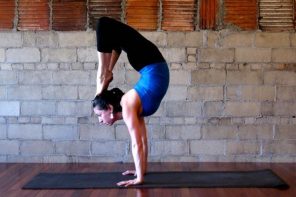Yoga popularizer, entrepreneur, and guru B. K. S. Iyengar died on Wednesday in the Indian city of Pune at the age of 95. The “Lion of Pune” had a robust persona that will be greatly missed, not only by family and friends, but also by countless students across the world.
Students revered him for his fiercely confident, direct, and demanding guidance at his Ramamani Iyengar Memorial Yoga Institute in Pune and far beyond. Iyengar’s widespread influence can be attributed to his success in constructing and disseminating what is known as “Iyengar Yoga,” an idiosyncratic rendition of modern postural yoga, a complex and contested collection of systems consisting of some combination of asana, or “posture,” synchronized with the breath through pranayama or “breath control.”
Iyengar was born Bellur Krishnamachar Sundararaja Iyengar on December 14, 1918, in the Indian state of Karnataka. He suffered through an agonizing childhood in which he lost his father and siblings to various illnesses, and was afflicted himself with tuberculosis, typhoid, and malaria. Already decrepit at the age of sixteen, Iyengar went to the Karnataka city of Mysore to study yoga with his brother-in-law, Tirumalai Krishnamacharya, who was said to have constructed a yoga system meant to strengthen the body through sequences of onerous postures and breathing exercises. The hope was that Krishnamacharya’s yoga would improve Iyengar’s physical state. It did.
Iyengar became the most famous among the yoga prodigies and teachers to have studied under Krishnamacharya. After studying for three years with his guru, Iyengar moved to Pune, where he developed his own postural yoga system that was informed by Krishnamacharya’s approach and techniques as well as increasingly refined biomedical understandings of the body. Beginning in the 1950s, Iyengar attracted wealthy and influential students, including violinist Yehudi Menuhin, whose patronage, enabled him to teach yoga in London, Switzerland, the United States, and Paris.
Before Iyengar and other entrepreneurial yogis popularized it, yoga had moved from the counterculture of Indian ascetic renouncers, to the counterculture of turn-of-the-century American practitioners of tantra, to the counterculture of Transcendentalism and metaphysical religion, to the counterculture of proponents of physical culture. It wasn’t until the 1960s that it no longer opposed prevailing cultural norms and became readily available to the masses.
The 1960s proved to be the ideal time for the global dissemination of yoga, since it witnessed the British-American counterculture and the lifting of immigration restrictions to much of Western Europe and the United States, resulting in an influx of Indian gurus ready and eager to deliver yoga to a counterculture grasping for something radically opposed to what they perceived as the puritanical, body-negating Protestantism of their upbringing.
Iyengar was a part of a much larger movement of Indian gurus—including Muktananda of Siddha Yoga, Maharishi Mahesh Yogi of Transcendental Meditation, Bhaktivedanta Prabhupada of the International Society for Krishna Consciousness—who exploited these trends by widely and transnationally disseminating tantric, meditational, devotional, and postural yoga systems. The most successful attempts at dissemination occurred when gurus conceded to consumerist pop culture trends, responding to a transnational market in which wares could be easily fit into individualized lifestyles. These were most often the attempts of postural yoga gurus, especially Iyengar.
Iyengar published his Light on Yoga in 1966, and it instantly became the standard reference on postural yoga throughout the world. His book was particularly attractive to a consumerist audience insofar as it included step-by-step instructions so that individuals could choose yoga as one part of their self-development regimen without having to give up other lifestyle commitments. They could do yoga without leaving home.
The book provided detailed biomechanical explanations of each posture and its fitness and health benefits. Iyengar prescribed a disciplined form of body maintenance, famously referring to the body as a “temple” and arguing, “[The yogi] conquers the body and renders it a fit vehicle for the soul.” He prescribed the use of fitness tools, such as belts, bricks, and ropes, to assist the yogi in her quest to “conquer” the body.
Iyengar established authority for his new system of Yoga by claiming ties to the yoga tradition presented in the South Asian text popularly recognized as the “classical” source, the Yoga Sutras, usually attributed to Patanjali, as well as to later hatha yoga developments. Iyengar even responded to recent debates about yoga’s identity and transmission by introducing an invocation to Patanjali at the beginning of each yoga class, though he insisted that while yoga was a part of an ancient South Asian yoga transmission it was not specific to any religious tradition and was universally accessible.
In 1975, Iyengar established the Ramamani Iyengar Memorial Yoga Institute, named after his wife who had died in 1973. The Institute, which functioned as the center for teacher training, greatly augmented the number of yoga teachers who received official training in Iyengar Yoga and became the headquarters from which to disseminate the Iyengar system. Today, there are thousands of Iyengar Yoga teachers and millions of practitioners in over seventy countries across the world.
Some yoga advocates and pop culture critics have suggested that popularized yoga reflects only the impulse to commodify yoga or to reduce it to mere physical practices exclusively for the sake of hedonistic or utilitarian aims. Iyengar disagreed. To him, yoga, even in some of its popularized forms, was far larger than such stereotypes suggested.
In the end, the legitimacy of Iyengar Yoga and other popularized yoga systems is not subject to meaningful debate. Long before the twentieth century, yoga was a contested and contextual phenomenon, leaving no single model against which we can measure the authenticity of those invoking its name. What we can say with confidence is that Iyengar and his yoga system, although products of their temporal, spatial, and even corporeal contexts, have put an enduring imprint on the vast history of yoga.




